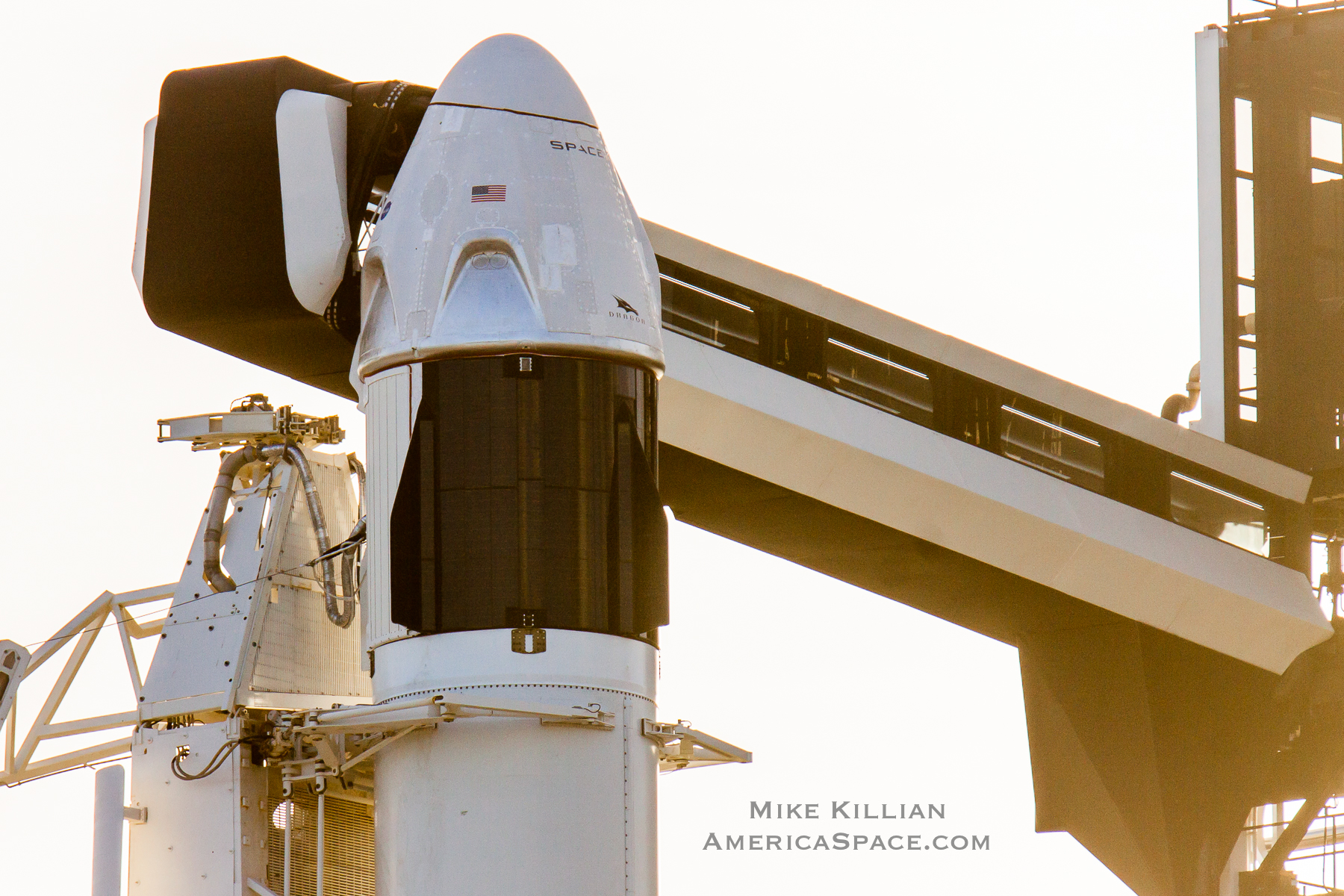
UPDATE – NASA and SpaceX now are targeting 8 a.m. EST Sunday, Jan. 19, for launch. The abort test has a six-hour launch window. Teams are standing down from today’s launch attempt due to poor splashdown and recovery weather.
For tomorrow’s launch attempt, meteorologists with the U.S. Air Force 45th Space Wing predict a 60% chance of favorable weather toward the opening of the window with a 40% chance toward the end of the window. The primary concerns for launch day being the thick cloud layer and flight through precipitation rule during the launch window.
WATCH THE LAUNCH LIVE HERE ON SATURDAY!
ORIGINAL REPORT – NASA and SpaceX are ready for the long-awaited In-Flight Abort Test of an un-crewed Crew Dragon spacecraft from historic Pad 39A at the Kennedy Space Center (KSC) in Florida. It’s the final major test hurdle for Elon Musk’s company before NASA certifies them to begin launching astronauts to and from the International Space Station beginning later this year.
SpaceX has already flown an uncrewed test to and from the ISS, and tested the spacecraft’s ability to abort from the rocket and launch pad in the event of a ground emergency, but now they will actually launch the capsule to demonstrate its in-flight abort capability, simulating an ascent emergency where the spacecraft would safely escape from a failing rocket during launch.
.
Lined up for the Saturday launch is the veteran Falcon 9 first-stage core tailnumbered B1046. It was the first Block 5 variant of the booster to fly when it lofted Bangladesh’s Bangabandhu-1 communications satellite to geostationary altitude back in May 2018. It went on to deliver Indonesia’s Merah Putih communications satellite the following August to become the first Falcon 9 to record two geostationary missions. And in December 2018, it was the first orbital launch vehicle to record three missions when it flew Spaceflight Industries, Inc.’s heavyweight SSO-A SmallSat Express, earning itself yet another accolade for the largest number of discrete payloads (64) on a single SpaceX mission.
But sadly, all good things must end and Saturday’s mission promises to be the final swansong for B1046. When its nine Merlin 1D+ first-stage engines ignite at some point midday EST, they will make B1046 only the third Falcon 9 core to undertake a fourth launch, coming on the heels of B1048 last November and B1049 earlier this month. And although SpaceX reportedly looked into designing the Crew Dragon In-Flight Abort Test to “save” B1046, the violent energy and supersonic dynamism of Saturday’s flight is expected to destroy the core once Dragon aborts.
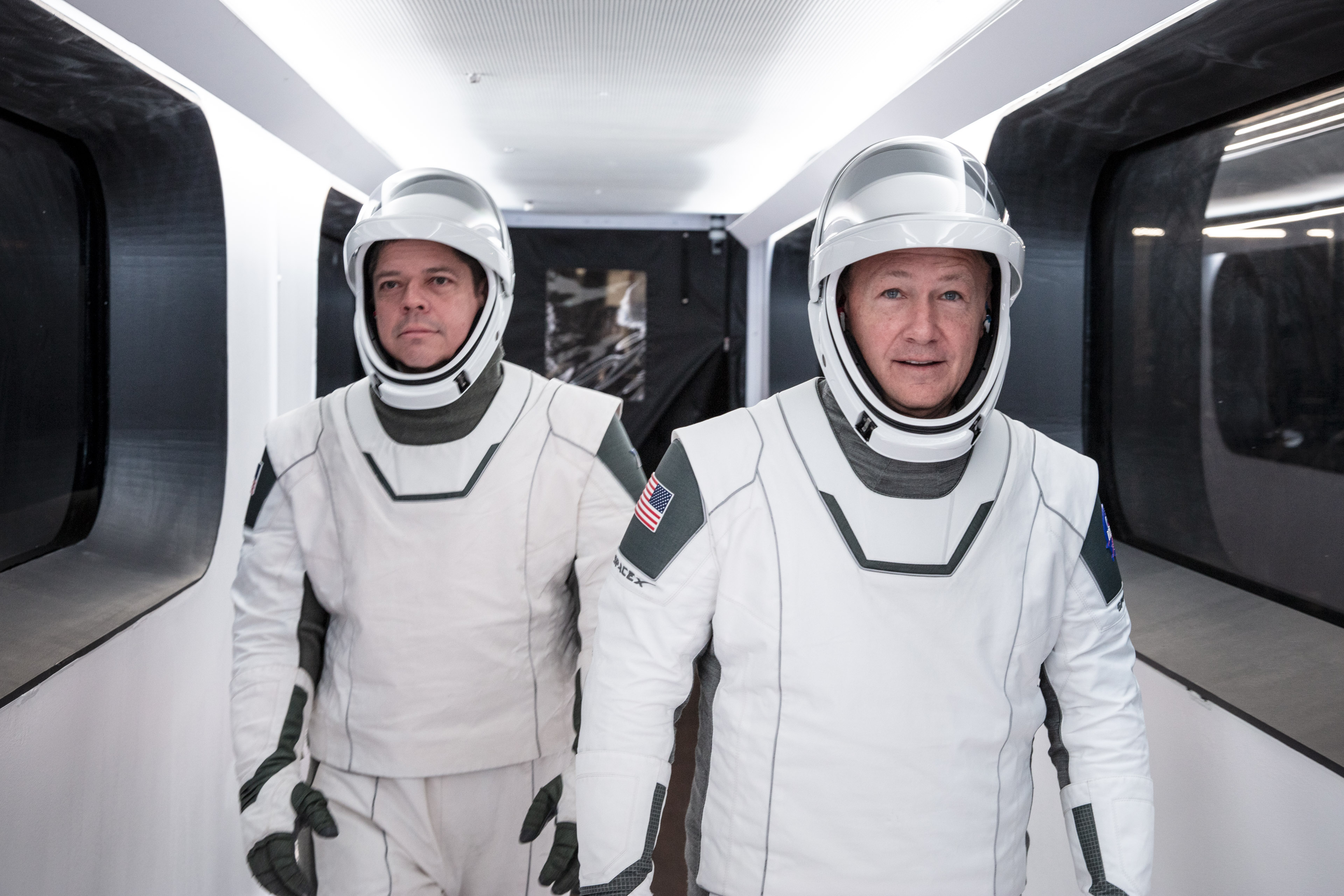
In-Flight Abort Test, astronauts Bob Behnken & Doug Hurley rehearsed what they’ll experience during their missions. Photo: NASA
After all, if living, breathing astronauts were aboard the Crew Dragon for this mission, their safety in the event of a major in-flight accident would overwhelmingly trump the survival of the booster.
In November 2018, the Federal Aviation Administration (FAA) published its “Draft Environmental Assessment for Issuing SpaceX a Launch License for an In-Flight Dragon Abort Test”, which detailed the parameters of the exercise in great depth. “The launch scenario where an abort is initiated during the ascent trajectory at the maximum dynamic pressure (known as “Max Q”) is a design driver for the launch abort system,” it was noted. “It dictates the highest thrust and minimum relative acceleration required between Falcon 9 and the aborting Dragon. As the in-flight abort would occur during the first-stage portion of the launch trajectory, the second stage of the Falcon 9 would be simplified.”
This simplication of the second stage manifests itself most visibly through the absence of the Merlin 1D+ Vacuum engine, unneeded on this flight. “The components essential to propellant loading operations would be carried,” the FAA assessment continued, “but the thrust chamber, turbopump, thrust vector control actuators and other components required for performing second-stage burns would be omitted, as the mission concludes partway through the first-stage ascent burn.”
Described by NASA as one of SpaceX’s “final major tests”, the mission is another important step towards achieving a decade-long goal of sending humans to the International Space Station (ISS) in a U.S.-made spacecraft, atop a U.S.-built rocket and from U.S. soil, since the 2011 retirement of the Space Shuttle fleet. SpaceX initially won funding to develop Crew Dragon through the Commercial Crew Development (CCDev) solicitation process. It was later picked as a Commercial Crew integrated Capability (CCiCap) finalist in August 2012 and won the coveted Commercial Crew transportation Capability (CCtCap) contract—alongside Boeing—in September 2014 to actually develop the spacecraft.
Teamed with its engine-less second stage, B1046 was trundled from the horizontal integration facility out to Pad 39A last week and successfully completed a customary Static Fire Test on Saturday, 11 January. As detailed by AmericaSpace’s Mike Killian, SpaceX has endured a pair of catastrophic Falcon 9 failures: an on-the-pad explosion of the Amos-6 mission in September 2016 and the structural breakup of the CRS-7 mission during first-stage flight in June 2015. “And while both NASA and SpaceX are confident that the issues which caused those accidents are resolved,” he wrote, “it does not change the fact that those events are exactly why an abort capability is needed for crews to begin with.”
Weather conditions for Saturday are currently 90-percent favorable, with the launch window opening barely 45 minutes after local sunrise. “Winds will become southeasterly on Saturday, forming some shallow coastal showers,” noted the 45th Weather Squadron at Patrick Air Force in its L-3 briefing. “The primary weather concern is flight through precipitation with those showers.” Should the attempt be scrubbed on Saturday, the weather threatens a marked downturn on Sunday and Monday, with the likelihood of acceptable conditions deteriorating to 30-40 percent ahead of a frontal system moving into the Panhandle area. And that carries implications for SpaceX’s next launch on Monday, 20 January, which will see the previously flown Block 5 core B1051 embark on its third mission to boost the next batch of Starlink satellites to orbit.
In order to keep Saturday’s mission a close analog to the real thing, SpaceX and NASA teams will practice launch day end-to-end operations, including final inspections of the Crew Dragon and the closeout of its side hatch.
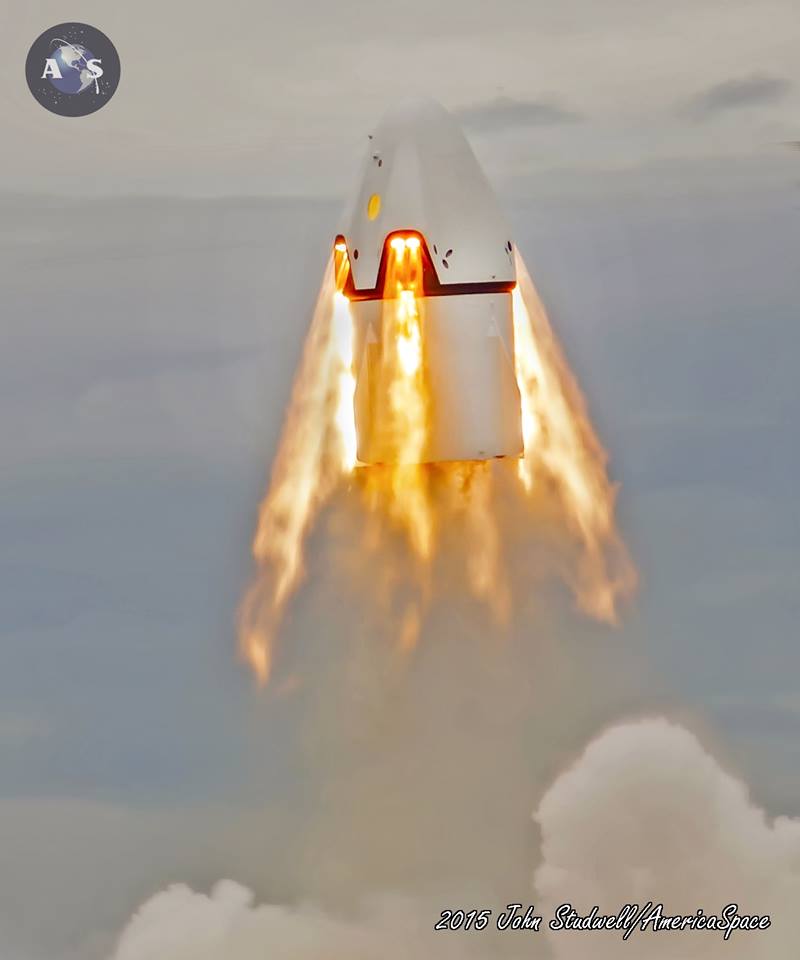
Liftoff will occur as normal, with the B1046/Crew Dragon stack following a standard trajectory to reach the ISS, with the exception of launch azimuth to approximately Mach 1. “The Falcon 9 would be configured to terminate thrust, targeting the abort test shutdown condition, simulating a loss-of-thrust scenario,” the FAA assessment explained. “Dragon would then autonomously detect and issue an abort command, which would initiate the nominal start-up sequence of Dragon’s SuperDraco engine system.” Separation of the spacecraft from the booster is expected to occur 83-100 seconds into flight.
The SuperDracos have demonstrated their awesome power—both for good and ill—more than once in recent years. In May 2015, SpaceX conducted a pad abort test of a mockup Crew Dragon from SLC-40, in which the eight sidewall-mounted thrusters ignited to push the spacecraft from a ground-level platform to a peak altitude of 3,561 feet (1,187 metres) in just a handful of seconds. Punching out 120,000 pounds (54,400 kg) of thrust, the SuperDracos burned furiously to completion, before the Crew Dragon’s pressurized capsule separated from its unpressurized trunk and parachuted to a smooth Atlantic splashdown. But more recently, during an April 2019 ground-based static fire test of the SuperDracos following last March’s unpiloted Demo-1 Crew Dragon mission to the ISS, a leaky valve caused nitrogen tetroxide oxidizer to enter high-pressure helium tubes and triggered a catastrophic explosion. The Demo-1 spacecraft was destroyed in the accident. Corrective actions were subsequently implemented and last November a successful full-duration SuperDraco test-firing was performed without incident.
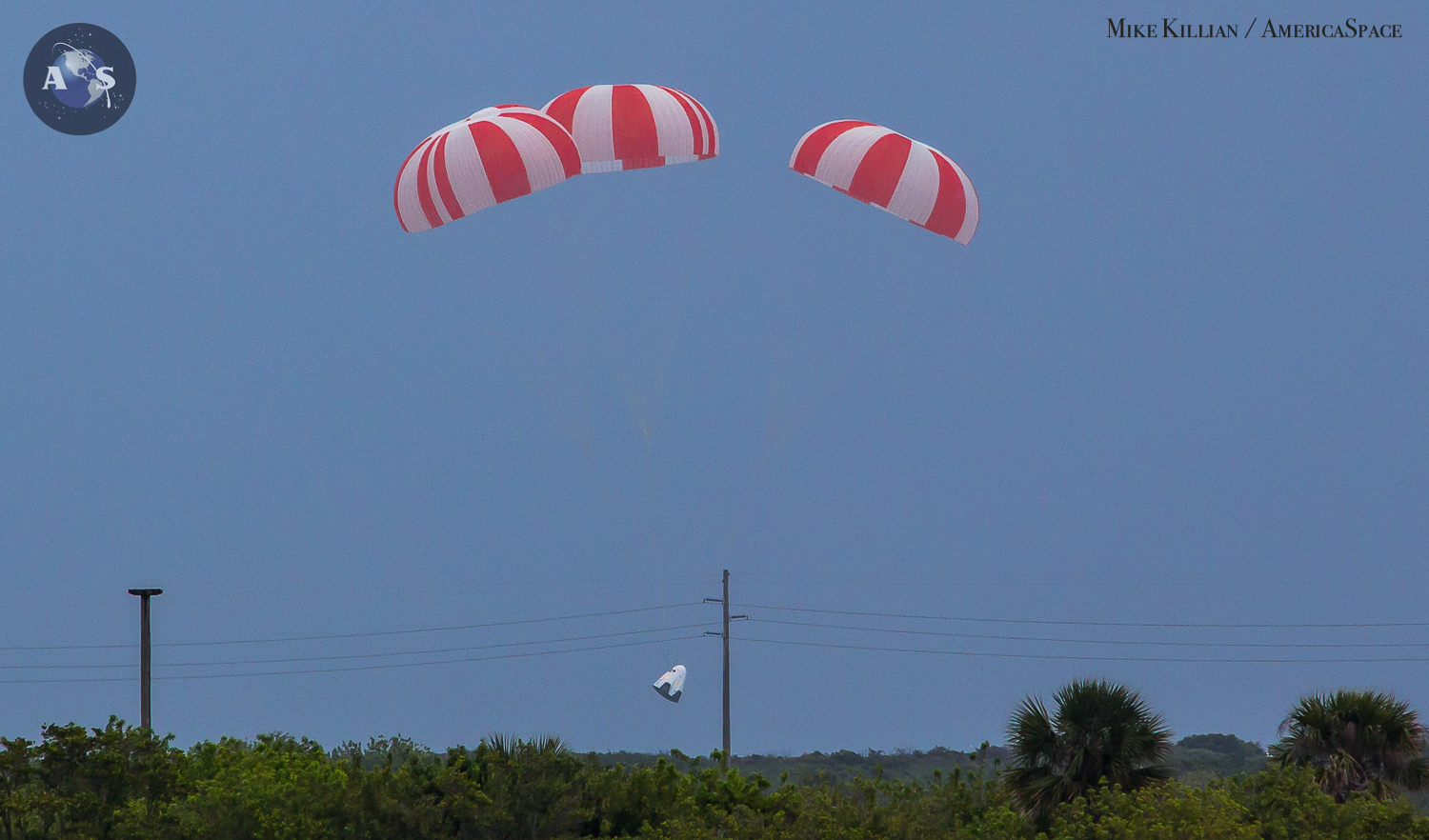
Although Saturday’s In-Flight Abort Test will occur at significantly higher altitude than either the May 2015 pad abort test or last April’s unlucky failure of the Demo-1 vehicle, the sheer power of the SuperDracos as they flare to life promises to be a spectacular sight. As they start burning, the Falcon 9 will receive a command from the Crew Dragon to terminate thrust on all nine of B1046’s Merlin 1D+ engines. “Dragon would then separate from Falcon 9 at the interface between the trunk and the second stage with a frangible nut system,” continued the November 2018 FAA assessment. “Under these conditions, the Falcon 9 vehicle would become uncontrollable and would break apart. SpaceX would not attempt first-stage booster flyback to KSC, CCAFS or a drone ship.”
“After Crew Dragon’s SuperDracos shut down, the spacecraft will passively coast to apogee, the highest point in its arc,” NASA noted in an update last week on its website. “Near apogee, Crew Dragon’s trunk will separate and the smaller Draco thrusters will re-orient the spacecraft for re-entry and parachute deploy. At the appropriate conditions, Dragon’s drogue and main parachutes will sequence to provide for a soft landing in the Atlantic Ocean near SpaceX Dragon recovery teams.” The FAA assessment indicated that drogue parachute deployment will occur at an altitude of six miles (9.6 km) and the main parachutes will begin to unfurl about a mile (1.6 km) above the ocean.
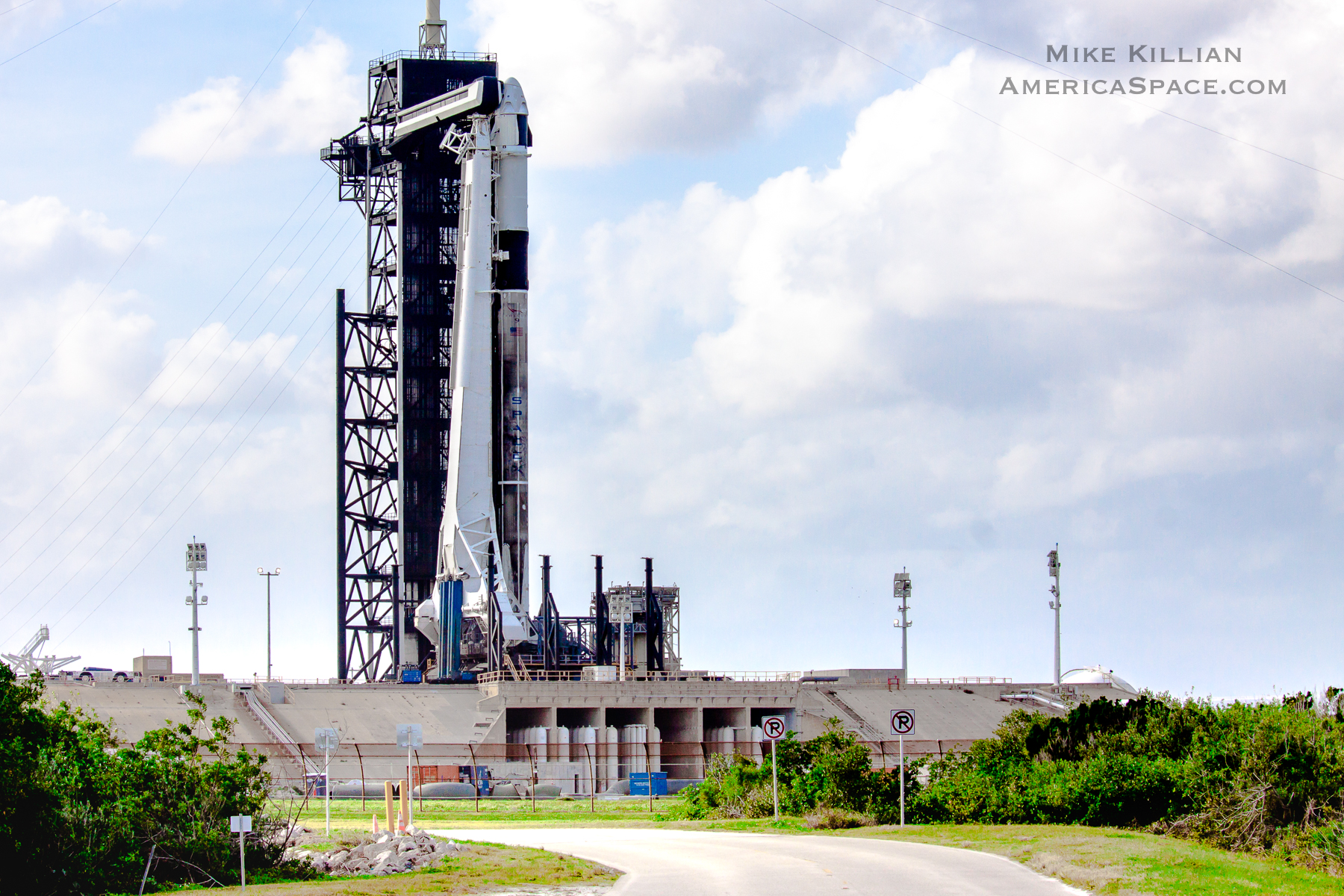
And so the hapless B1046 will “aerodynamically break-up offshore over the Atlantic Ocean”, with the exact timing of its final death-throes dependent upon prevailing winds and anticipated minor variations in vehicle attitudes and positions. Either way, it will occur at some point shortly after Crew Dragon’s separation or during re-entry.
Following Saturday’s splashdown of Crew Dragon, Air Force Detachment-3 personnel will observe the spacecraft and practice their approach in the open ocean to mimic an actual rescue operation. Described by NASA as one of SpaceX’s “final major tests” ahead of Behnken and Hurley’s flight, the In-Flight Abort Test is a hairy eventuality that nobody wants to see unfold in real life. SpaceX has identified the chance of an in-flight emergency on actual Crew Dragon missions as an “unlikely event”, but even in the absence of real humans aboard, one thing is certain: Saturday’s mission to destroy a workhorse booster and save a spacecraft promises to put on an impressive show and inevitably will cause a few hearts to leap into throats.
.
.
FOLLOW AmericaSpace on Facebook and Twitter!
.
.




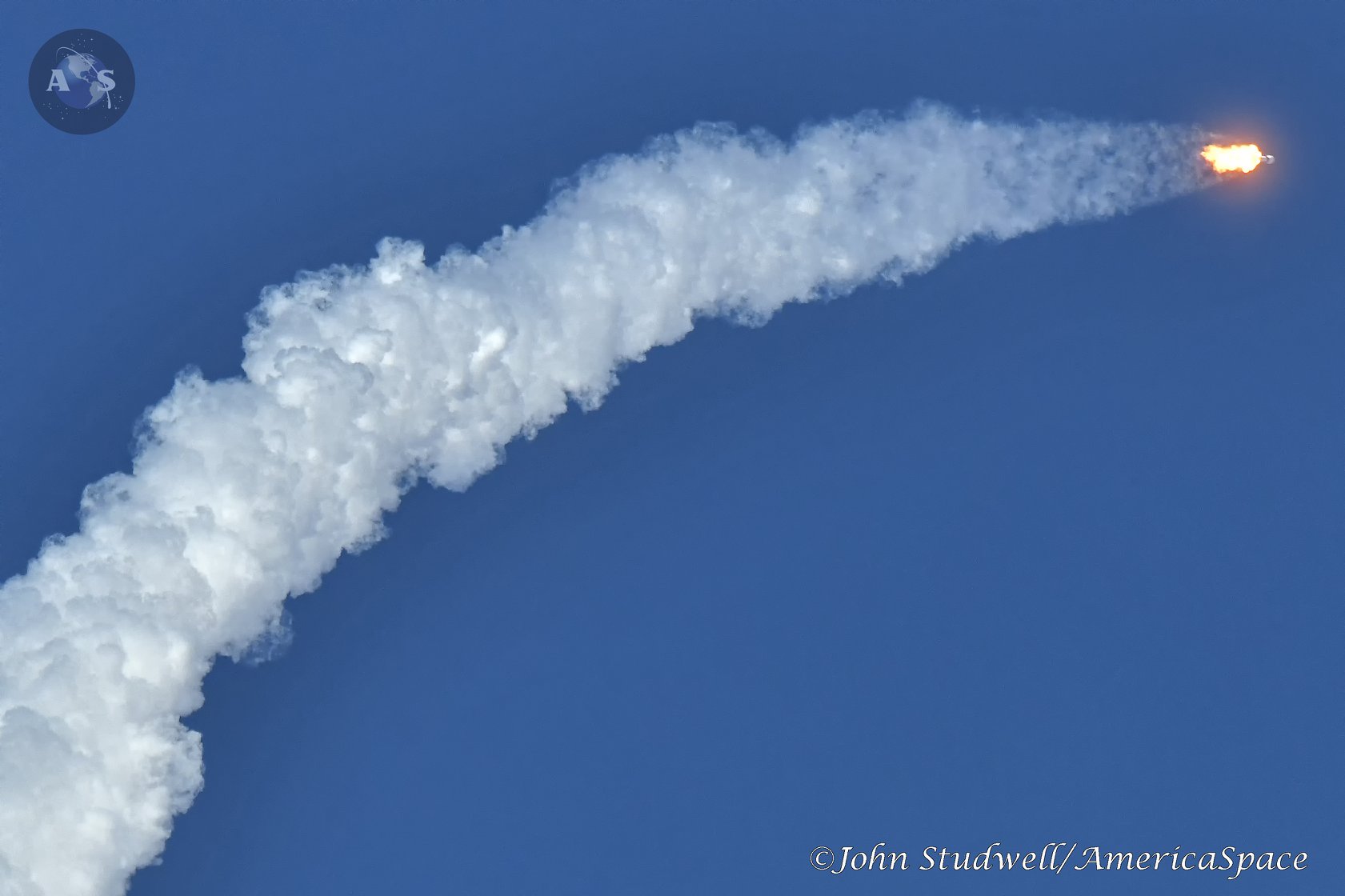
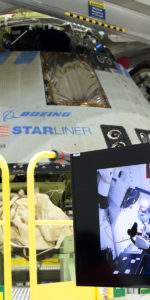
Based upon the strict weather parameters in place for this In Flight Abort test, it appears they will be even stricter for future crewed launches of Dragon and Starliner.
Consequently, it means there could many scrubbed launches for both vehicles due to their impact points in the Atlantic Ocean in the event of an actual In Flight Abort. Complicating matters, I expect, are the instantaneous launch windows – particularly in darkness.
Alas the good old days of shuttle launch delays may also blight this new era of Commercial Crew(!)